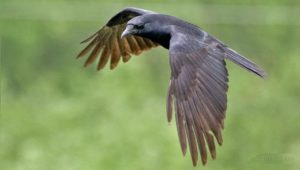
Above Image source: “Crow in Flight -Delaware-8” by Pheanix – originally posted to Flickr as Crow in Flight. Licensed under CC BY 2.0 via Wikimedia Commons

Image source: Derek Harper [CC BY-SA 2.0 (http://creativecommons.org/licenses/by-sa/2.0)], via Wikimedia Commons
Who sees more–we, or the crows?
No one could view the farm at Widdicombe, U.K. (pictured above), without reflecting on the unique perspective of those crows flying over the grassy field.
It’s humbling to realize that those crows may be much better-informed, visually, than ourselves.
If you don’t mind experiencing a bit of humility, take a look at the video below, “How Birds Really See the World,” and then, read on about how the sharp observation of crows saved two parrots, twice, and educated a clueless bird watcher.
Is that the same crow I saw yesterday?
Stereotypical thinking occurs when one does not see uniqueness.
In the case of birds, who seasonally will either flock or act as individuals, often, we don’t have enough information to understand what is unique about the bird species, or an individual bird, or to understand whether or not that generic-looking brown bird we just saw was the same one we saw yesterday.
I grew up being clueless about wild animal behavior. It wasn’t until I was an adult that I realized that, like humans, wild animals have habits, as well as homes, and an individual animal I saw one day was very likely the same one I had seen the day before and the one I will see tomorrow. This goes for that wasp, squirrel, lizard, quail, and the deer and possum families I rarely see but whose paths stay freshly trampled.
For a while, I perceived only my own interest in watching wildlife. It took two lessons for me to realize that the neighborhood crows, who seasonally roosted in the eucalyptus trees a few houses away, were watching me and my family, in return, and taking a benevolent interest in our two pet parrots, whom I sometimes placed outside in what I considered a safe enclosure.
My lessons from the neighborhood crows
For my first lesson, I was called outside by a noisy murder (flock) of crows circling over the parrot enclosure. On looking around, I saw that the neighbor’s black cat was lurking in the vicinity, pointedly interested in the parrots. This cat appeared to be the focus of the crows’ concern. Of course, I put the parrots inside. However, I wasn’t exactly sure whether I had imagined or correctly interpreted that the crows had intentionally called me to warn of this danger.
For my second lesson, when the crows circled rowdily above the parrot enclosure, I looked around, and saw nothing at first. However, being impressed at the crows’ persistent warnings, I searched the sky. Almost higher than I could see, a hawk circled slowly.
The predominant hawk in my region of California is the red-tailed hawk. I am reading on Wikipedia that this is one of three species commonly called a “chickenhawk,” although the Red-tailed hawk rarely attacks full-sized chickens. I am reading that, when diving, it may exceed 120 miles per hour.
I had not realized the parrots required a covered enclosure.
Nor had I realized these crows knew my parrots, and viewed them with compassion and a protective nature, and possibly viewed me and my family favorably as they watched us play with the parrots, and watched us give them the sprinkler baths which caused the parrots to open their wings so beautifully.
The end of my self-centered bird studies
Until those incidents, it had been my challenge to try to see birds through binoculars, to look up birds in my Audubon bird identification book, and to try to see which bird might be making a certain bird call.
Although I had read books of Beatrix Potter, Peter Rabbit was a mere fiction to my way of thinking.
Never, until the incidents with the crows, did I seriously consider that an ordinary crow, or blue jay, or maybe even the lizard I stepped over every day in the garden, could be a neighbor who knew me, knew my family, and knew our pets and our daily routines, just as we knew them, though we previously only saw the crows as generic members of a seasonal rookerie who at times traveled en masse to wheat fields across the river.
What is most impressive about the crows is that they had taken an actively protective interest in our parrots. They saw dangers from afar (good eyesight), realized the potential of harm (comprehension), acted to prevent the potential harm (compassion), and realized they had a way, by acting collectively, to communicate the danger to the humans who could protect the parrots. (Would that be a reverse form of anthropomorphism being demonstrated by crows, surpassing empathy?)
Now, with the Internet, rarely observed animal behavior in the wild is available online, to inform scientific research, and inform us of the capabilities and potential of the animals around us.
In this article, you will see:
- a few YouTube videos demonstrating unusual crow behavior,
- a few anecdotes and studies connecting crow behavior to intelligence,
- some articles on how scientists are conducting research on crow brains and intelligence, and
- a few comments on benefits the crow research may foster.
Click next page to see a video demonstrating another instance of empathetic crow behavior.



